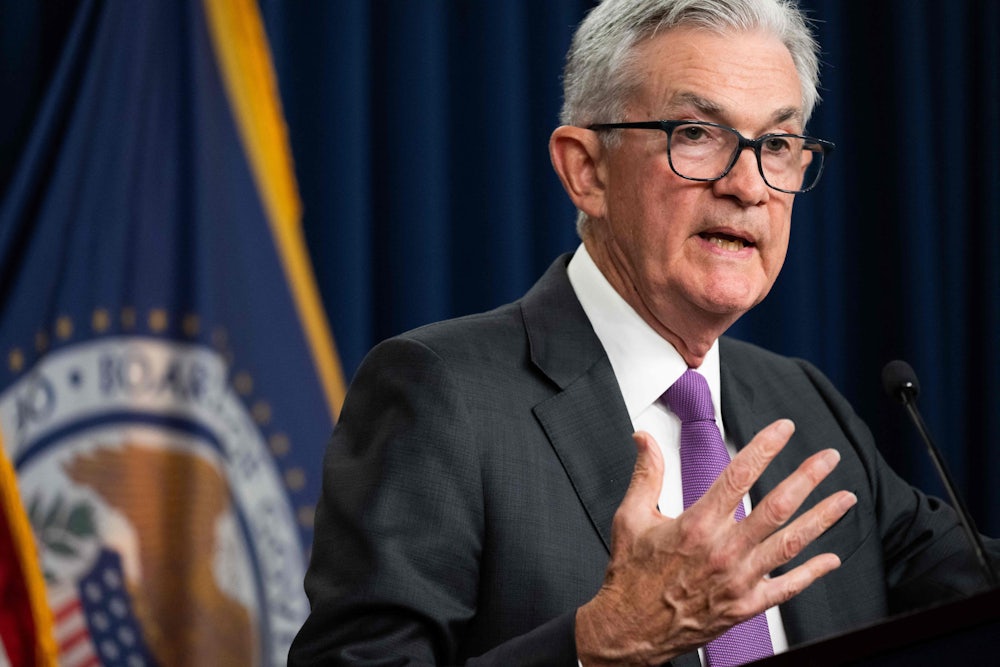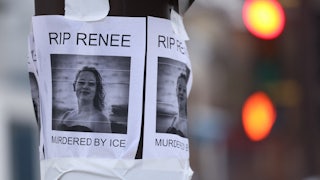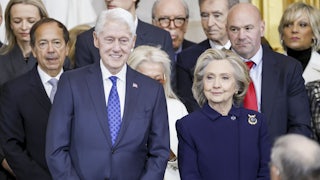The Covid-induced inflation crisis is pretty much over. The consumer price index peaked at 9.1 percent in June 2022 on an annualized basis (that is, compared to June 2021), then fell for 12 consecutive months. It ticked up slightly in July 2023 to 3.2 percent, the Bureau of Labor Statistics reported Thursday, but “core” inflation (that is, the inflation rate minus volatile food and energy prices) actually dropped slightly, to 4.7 percent. The nonannualized numbers, The Wall Street Journal pointed out, were even more favorable. Inflation rose a mere 0.2 percent in June and July, both for the CPI and for core inflation.
This should be cause for celebration, but it isn’t. Partly the problem is that next month’s CPI report is expected to reflect this month’s rise in gas prices, and partly it’s because business reporters, as I observed in June, are constitutionally unable to identify any economic indicator as favorable. A good recent example is the collective yawn that greeted the news on August 3 that productivity growth, after declining for a widely reported five consecutive quarters (for Covid-related reasons) rose 3.7 percent in the second quarter of 2023. Apart from Bloomberg, Reuters, and American Public Media’s Marketplace, nobody seemed to notice.
But there’s another reason everybody’s slow to declare the inflation crisis over: The Federal Reserve’s target annual inflation rate of 2 percent is unreasonably low. Three percent inflation is just fine. And in fact, inflation shouldn’t be the Fed’s only concern in setting interest rates—but more on that in a minute.
Sticklers will point out that the Fed’s target isn’t based on the CPI, which it considers a faulty metric, but the Personal Consumption Expenditures Index, or PCE. We won’t know the PCE for July until August 31. But the PCE for June was the same as the CPI for June—3 percent.
The Fed set the 2 percent target rate in 2012, declaring it “most consistent over the longer run with the Federal Reserve’s statutory mandate.” At the time, Republicans were predicting confidently (and, it turned out, quite erroneously) that President Barack Obama would send inflation into the stratosphere. Two years earlier, with unemployment at a whopping 9.8 percent, then-Senator Bob Corker and then-Representative Mike Pence, Republicans of Tennessee and Indiana, respectively, sponsored legislation requiring the Fed to abandon its “dual mandate” to consider both unemployment and inflation when setting interest rates, and instead to focus solely on inflation, which was then a pitiful 1.1 percent. That was the political environment in which the Fed set its target inflation rate at 2 percent.
To this day, the official rationale the Fed supplies for the 2 percent figure devotes more space to addressing potential criticism that 2 percent is too high than to addressing potential criticism that it’s too low. Also to this day, the Fed, ignoring its dual mandate, does not set an unemployment target. The 2012 announcement of the 2 percent inflation target explained this away with some mumbo-jumbo about “nonmonetary factors that affect the structure and dynamics of the labor market” (as if the same were not true of wages and prices). The real reason was that the Fed’s most powerful and vocal constituency was, and remains, the banks, which don’t care one whit about people getting thrown out of work.
Why 2 percent? Actually, before 2012, the Fed had never identified an inflation target at all. But in 1988, with inflation running nearly 10 percent, New Zealand’s finance minister blurted out on television that he wanted inflation to rise no higher than 1 percent. That obliged New Zealand’s central bank to set, in 1989, an official inflation target of 2 percent (on the presumption that if you wanted 1 percent you had to leave a bit of slack). Canada’s central bank followed suit in 1991, adopting an inflation target and setting it at 2 percent. From there the idea spread to England, Sweden, Australia, Israel, South Korea, and so on. The United States came relatively late to the party, adopting inflation targeting in 2012 under Fed Chairman Ben Bernanke, who for a decade had promoted the idea as a way to make Fed policymaking more predictable. Among other advantages, adopting an inflation target helped Bernanke dismantle the policy of deliberate obfuscation under Fed Chairman Alan Greenspan.
Inflation targeting has frequently drawn criticism. In 1997 Mervyn King, then of the London School of Economics, declared inflation targets “all the rage,” and complained that it was turning economic policymakers into “inflation nutters.” Nearly always, the target has been the same magical 2 percent. “It wasn’t ruthlessly scientific,” Michael Reddell, one of the New Zealand economists who’d settled on that number, confessed to Quartz in June 2021. Sherlock Holmes had his 7 percent solution of cocaine; the world’s central banks have their 2 percent solution of annual price increases. It worked better than the monetarist money-growth targets previously favored by the Fed, which Greenspan declared obsolete in 1993. But it was still pretty arbitrary.
The timing of the Fed’s adopting a 2 percent inflation target was, to say the least, bizarre. Do you remember worrying about inflation in January 2012? Me neither. Inflation was 2.9 percent, which, yes, is higher than 2 percent. But with the economy still struggling to recover from the Great Recession, that was a sign of economic strength, not weakness. In The Washington Post, the news appeared under the heading, “Inflation Up Slightly in January.” The real worry was that the unemployment rate, though on a downward trajectory, was still 8.3 percent. “We have made real progress,” Obama said when the January 2012 jobless numbers came out. “Now is not the time to stop.” The economic recovery proved a slow one; a year later, unemployment was 7.9 percent, and a year after that it was 6.6 percent, still above the pre-recession level.
Whatever the rationale in 2012, by June 2017 a group of prominent liberal economists that included Jason Furman, chairman of the Council of Economic Advisers under Obama, and Nobel laureate Joseph Stiglitz, wrote then–Fed Chair Janet Yellen to say the 2 percent target was obsolete. They noted a “lack of evidence that moderately higher inflation would harm Americans’ standard of living” and said “a tighter labor market would improve Americans’ standard of living.” That proved, post-Covid, to be the case. Unemployment has dropped from 4.4 percent in June 2017 to 3.5 percent today, and—even with 3.2 percent inflation compared to 1.6 percent inflation back in June 2017—the nonprofit Economic Policy Institute was able to report in March that low-wage workers experienced “historically fast real wage growth.” The picture was less favorable for the middle class: For two years real average hourly earnings lagged inflation. But that ended in May, and now real average hourly earnings are rising. There’s some doubt about whether they’ll continue to rise, but that’s because the Fed is expected to keep raising interest rates. The reason for that is the 2 percent inflation target. Since 2020, 2 percent has been less of a hard ceiling and more based on long-term averages, as it should have been all along, but 2 percent is still too low.
Don’t take my word for it. Laurence Ball, an economist at Johns Hopkins, pointed out in March to Jeff Sommer of The New York Times that the most fearsome inflation-fighter in American history, Paul Volcker, vacated his Fed chairmanship in 1987 with inflation at 4 percent. This was, remember, three years after President Ronald Reagan won reelection by selling Americans on the idea that it was “morning in America.” Ball told Sommer: “If 4 percent was good enough for Volcker, it should be good enough for us.” Even inflation hawk Larry Summers has suggested he can live with a 3 percent inflation target.
The economist Olivier Blanchard of the nonprofit Peterson Institute for International Economics argued last fall that the target should be 3 or even 4 percent. Inflation is an economic indicator that’s affected strongly by public perceptions. When inflation is low, Blanchard reasoned, people don’t think about it, and when it’s not low they do. So why not measure how often they think about it? Blanchard cited a delightful 2022 paper that did just that, by economists Oleg Korenok of Virginia Commonwealth University, David Munro of Middlebury College, and Jiayi Chen, a graduate student in computer science at the University of Virginia. The paper identified the point at which the word “inflation” started turning up a lot in Google searches. The answer was … between 3 and 4 percent.
If the inflation target were lifted to a still-conservative 3 percent, you wouldn’t have to be in the know to be aware that the inflation crisis is over. A more radical alternative would be to make the Fed substitute for an inflation target a “misery index” target. Invented by the late Arthur Okun, chairman of the Council of Economic Advisers under President Lyndon Johnson, the misery index is the unemployment rate plus the inflation rate. It therefore encompasses both halves of the Fed’s dual mandate to curb inflation and curb unemployment.
Candidate Jimmy Carter used this informal indicator to clobber President Jerry Ford in his 1976 presidential campaign, only to have candidate Ronald Reagan clobber him in a 1980 presidential debate with a misery index that, Reagan said, had risen during Carter’s presidency from 12.5 to 20. (Actually 12.7 and 19.7, but who’s counting?) Today, under President Joe Biden, the misery index is a breathtakingly low 6.7. That’s lower than it was during the presidencies of every Republican president from Richard Nixon to George W. Bush. Trump got it down to 5.8, but then it was only 6.8 when Trump entered office. (“You’re welcome,” I hear Obama muttering.)
The Fed probably thinks the misery index is too amateurish a measure on which to base monetary policy. But the 2 percent inflation ceiling, as we’ve seen, is not the product of lengthy mathematical equations. Time to abandon it and declare victory against inflation. The country doesn’t lack real problems—climate change, income inequality, etc.—and our time will be better spent pondering those. Inflation is last year’s problem.






